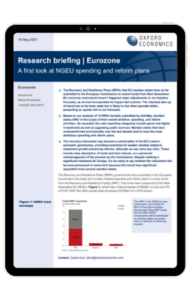Eurozone | A first look at NGEU spending and reform plans

The Recovery and Resilience Plans (RRPs) that EU member states have so far submitted to the European Commission to unlock funds from Next Generation EU (recovery instrument) haven’t triggered major adjustments to our baseline forecasts, as we had incorporated its impact last summer. The intended take-up of loans has so far been weak but is likely to rise when spreads widen, presenting an upside risk to our forecasts.
What you will learn:
- Based on our analysis of 18 RRPs formally submitted by mid-May, member states differ in the scope of their overall ambition, spending, and reform priorities. As expected, the main spending categories include green and digital investments as well as upgrading public services.
- The recovery instrument may become a central pillar of the EU’s macroeconomic governance, providing incentives for weaker member states to implement growth-enhancing reforms, although we see some key risks.
- Despite marking a significant milestone for Europe, it’s too early to say whether the instrument will become permanent in some form because this would face significant opposition from several member states.
Tags:
Related Services

Post
Food prices to bottom out in 2024, risks skewed to upside
Our baseline forecast is for world food commodity prices to register an annual decline this year, in aggregate, reducing pressure on food retail prices further downstream. However, we believe the risks to this forecast are overwhelmingly skewed to the upside.
Find Out More
Post
Battery raw material prices to recover
Battery raw materials prices bottomed out last quarter and we think a sustained recovery is looming. Midstream EV battery manufacturing activity has picked up again and inventories have returned to historical levels, suggesting upstream demand for raw materials will also bounce back.
Find Out More